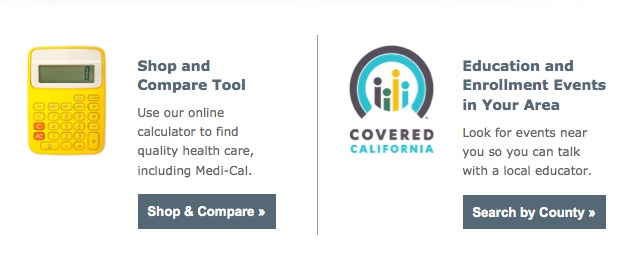
From the Covered California home page, www.coveredca.com. Those outside California, see healthcare.gov, the national site.
When you start looking into it, the Affordable Care Act (aka Obamacare) actually seems fairly straightforward and not that complicated. In a recent presentation sponsored by California Lawyers for the Arts, someone from the Actors Fund gave a clear summary of the program’s benefits and who is affected. The Actors Fund got a grant to help with patient education, and they, along with the Affordable Care Act itself, are available for telephone assistance.
In California, the Affordable Care Act is implemented as something called Covered California. (They neglected to reserve the coverecalifornia.com website, so its coveredCA.com.) Apparently, California is one of the most prepared states in the country for Obamacare. Also in California, acupuncture is covered by some of the plans.
Policies for nearly everyone across the country with individual insurance or Medicare will now have ten essential benefits included in their policies, including both outpatient and emergency services, free physicals, maternity and newborn care, MENTAL HEALTH and substance-use programs, prescription drugs, rehabilitative services and devices, preventive and wellness services, pediatric oral and vision, coverage of preexisting conditions, and certain preventive free tests and procedures. Self-insured and group/employer plans are not covered and many group/employer plans are allowed to grandfather in their benefits or lack thereof, as long as they don’t change the benefits. But no ACA plan can exist that doesn’t also exist in the private sector.
If you are 65 or older, you can’t be on an Affordable Care Act plan, you have to be on Medicare (or you can be on Medicaid/Medi-Cal if you make less than $15,414 a year). However, most Medicare recipients making less than $85,000 a year have already been eligible for reduced prescription costs as part of the plan. And those who have Part B of Medicare (the medical coverage beyond purely in-patient hospital coverage) also get the ten essential benefits.
And Medi-Cal is now available to anyone of any age based on income. (You used to have to have a child or one on the way.) Again, California has taken advantage of the Medicaid part of the Federal program. Some states have initially decided not to help their poor through this program. And some states are intentionally not educating their citizens about the program. But, again, California is making a strong effort in this area.
If your employer already offers insurance you have to take that, unless it amounts to more than 9.5% of your income, then you can take a Covered California plan, which lets you get assistance if you’re eligible (which many individuals and especially families are). Some companies, like Trader Joe, are discontinuing their employee coverage, thinking that employees will get a better deal on their own, since ACA premium assistance comes with income levels below $45,960 a year. In fact, the government’s assistance to help pay the insurance premiums can be quite high. You can go to CoveredCA.com and navigate to a calculator that will tell you how much assistance you will get, if any, and what plans are available to you.
There are four levels of insurance plans you can choose from—bronze, silver, gold, and platinum—the more precious the metal, the higher the percentage of medical expenses covered by the plan/the lower the co-pay, and also the higher the premiums are. But all plans have the free prevention items, like free yearly checkups, blood pressure checks, vaccinations, and even stop-smoking programs. Mental health coverage will be a major new benefit for many.
There are 13 insurance companies you can go with in California, and of those, six serve L.A. County. When you are comparing plans on the Covered California site, the current site shows only four companies in a row, so look to see if there are more to the right. (When I viewed it, dots below the boxes showed if there were more plans to look at, and seemed easy to miss. But the site may look different as they refine it. It’s all new!)
During the first year, the amount of assistance you can get with premium payments is determined by your 2012 taxes. But if your income changes at any point, you just tell Covered California and they adjust. The Actors Fund kept emphasizing that the program is very consumer-oriented.
The initial enrollment period this year is Oct. 1, 2013 – March 31, 2014. If you enroll before Dec. 15, coverage starts Jan 1, 2014. After this year, the yearly enrollment period will be Oct. 15-Dec. 7.
There is a single total penalty of $95 for the year or 1% of your income for not enrolling the first year, $325/2% the next year, and $695/2.5% per year beyond that. And adults under 30 (“the invincibles”) can choose a catastrophic plan if they want to.
For assistance, questions, and information, you can call Covered California at 800-300-1506, go into an office (soon), or go online. You can also call the Actors Fund Covered California helpline, at 855-491-3357. The Artists Health Insurance Resource Center, at Ahirc.org, gives information about provisions that directly impact artists and entertainers.
A representative at Covered California said they were interested in making the system better as they go, and he said they were open to feedback.
For your interest, there is a fascinating article, called “Testing, Testing,” that appeared in the Dec. 14, 2009, New Yorker, that compares health-care reform to the reform of the U.S. agriculture system at the start of the 20th century, a comparison the article’s author finds hopeful. As part of that hope, he peers into some of the pilot programs that were tucked into the bill. Newyorker.com/reporting/2009/12/14/091214fa_fact_gawande
Jeffrey Ainis is a freelance writer and editor who lives in Southern California
Jeffrey Ainis is a freelance writer, book editor, and an author of books on world music and composing. He also leads kirtan around the world.
